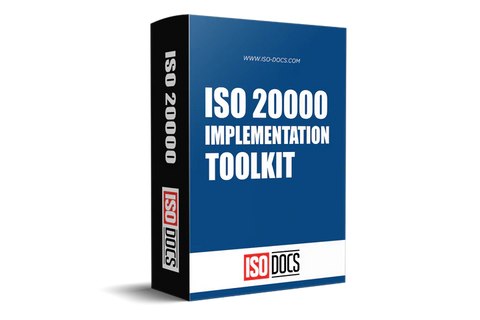ISO 20000 Procedure for Document and Record Control Template
What is Document Control?
Document control is a critical part of any ISO 20000 project, as it ensures that only the most up-to-date and approved versions of documents are being used. Document control also helps to prevent information overload and duplication of effort.

There are four key elements to document control in ISO 20000:
- Identification :All documents must be identified so that everyone knows what they are and what they are for. This includes giving each record a unique identifier (ID), title, and, if necessary, a revision number.
- Versioning :As a project progresses, documents will be updated and revised. Therefore, it is essential to keep track of all the different document versions so that everyone uses the same one. This can be done by assigning each new version a unique identifier (ID), date, and, if necessary, a revision number.
- Approval :Before a document can be used, it must be approved by the relevant authority. This ensures that the document is fit for purpose and meets all the requirements.
- Distribution :Once a document has been approved, it must be distributed to all the relevant stakeholders. This can be done electronically or in hard copy.
Objective:
Document and record control is an essential aspect of ISO 20000 and helps to ensure the consistency and accuracy of the information within the organization. It also allows authorized personnel to access relevant information quickly and easily. Documentation is essential for the successful management and operation of an IT service. Therefore, it must be compared up to date up to date so that authorized personnel can quickly and easily access and use it.
Document and record control is addressed in section 5.3 of ISO 20000. This section aims to ensure that the organization's documents and records are controlled and remain accurate and up to date. This is accomplished through the establishment of document and records control procedures.
The document and record control procedures must ensure that:
- Documents and records are created and updated as needed.
- Documents and records are reviewed and approved by reauthorized personnel.
- Documents and records are legible and understandable.
- Documents and records are stored in a secure location.
- Documents and records are retrieved as needed.
- Documents and records are disposed of when they are no longer needed.
The procedures must also specify who is responsible for each step in the process.
Why are Procedures Important to Document Control?
Procedures are essential to document control in ISO 20000 because they provide a consistent and repeatable method for controlling documents. By establishing procedures, organizations can ensure that documents are created, revised, and distributed in a controlled manner. This helps to ensure that only accurate and up-to-date information is disseminated throughout the organization. However, it is essential to note that procedures are not the only means of document control in ISO 20000. Organizations should also consider other methods, such as document management systems, to control their documents.
There are several reasons why procedures are essential to document control in ISO 20000.
Firstly, procedures provide a clear and concise description of how a process should be carried out. This makes it easier for employees to understand what is required of them and to follow the correct steps when carrying out a strategy.
Secondly, procedures ensure that all employees carry out the same process in the same way. This consistency is essential for quality control purposes and helps to avoid errors.
Thirdly, procedures can be used as a training tool for new employees or employees who need a refresher on a particular process.
Finally, documenting procedures is a requirement of the ISO 20000 standard, and failing can lead to certification being refused.
Types of Document Control Procedures?

- Change Control Procedures : Change control procedures specify the process for making changes to documents, including who is authorized to make changes, how changes are to be reviewed and approved, and how changes are to be implemented.
- Configuration Management Procedures : Configuration management procedures specify how documents are to be managed throughout their lifecycle, from creation to disposal. This includes methods for identifying and controlling document changes and practices for storing, retrieving, and distributing copies.
- Release Management Procedures :Release management procedures specify how documents are to be released for use, including who is authorized to release records, how releases are to be reviewed and approved, and how releases are to be implemented.
- Archiving Procedures :Archiving procedures specify how documents are archived, including who is authorized to archive documents, how archives are to be maintained, and how records are retrieved from archives.
List out the benefits of Document and Record Control in ISO 20000.?
- Document and Record Control ensures that only authorized and up-to-date documents are used.
- It protects against the use of old or obsolete versions of documents, which could lead to errors or problems.
- Document and Record Control helps ensure that documents are legible and easily accessible.
- It helps to speed up processes and reduce the risk of human error.
- Document and Record Control can improve an organization’s efficiency and help reduce costs.
- Facilitating the review and updating of documents and records promptly.
- Ensuring that only authorized individuals can access and modify documents and records.
- Providing a clear audit trail for all changes made to documents and records.
- Ensuring that all documents and records are properly stored and archived.



